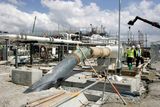Doing the maths: how real is Ireland's economic growth?
Official Irish statistics are being fattened up by massive tax inversions and the re-registering of companies, warns Dan White
After wrapping up the biggest pharma deal of the year, the merged Pfizer/Allergan group will probably take advantage of its ‘Irish’ status by quickly paying shareholders the $21bn of undistributed profits currently sitting on its balance sheet
The ESRI estimates that the Irish economy grew by 6.7pc in 2015 and is forecasting GDP growth of 4.8pc for this year. GNP, which is generally regarded as a better measurement of the underlying performance of the Irish economy, is also growing strongly, with the ESRI reckoning that it grew by 5.2pc last year and that it will grow by a further 5.3pc this year.
But how real is this economic growth?
Undoubtedly at least some of it is the real McCoy. The number of people at work grew by 56,000 to just under two million in the 12 months to the end of 2015, while average private sector earnings were up by 3.6pc over the same period. The bulging tax take, with Exchequer receipts running €3bn ahead of target for the first 11 months of 2015, also point to an economy that is in rude good health.
Measuring the true level of Irish economic activity has always been a tricky topic for economists. The generally accepted international standard is gross domestic product (GDP). The problem with GDP for Ireland is that it includes the undistributed profits of foreign-owned multinationals. This has the effect of artificially boosting the value of Irish economic output, since those profits belong not to Irish residents, but to the multinationals' overseas shareholders.
It is for this reason that gross national product (GNP), which excludes undistributed multinational profits, is the usually preferred measure of Irish economic output.
Unlike most countries, where GDP and GNP are virtually synonymous, the gap between Irish GDP and GNP is enormous - and still widening. The ESRI estimates that the value of Irish GDP in 2015 was €213bn, but the value of GNP was almost 15pc smaller, at just €182bn. For 2016, the ESRI is forecasting GDP of €232bn and GNP of €200bn.
However, having largely relied on GNP to gauge the true level of our economic output, there are now growing indications that it too is a flawed measure. The first sign that there might be less to Irish GNP than meets the eye came in a 2013 ESRI paper by John FitzGerald.
In the paper. Professor FitzGerald pointed to the phenomenon of overseas, mainly UK, PLCs re-registering as 'Irish' and the possible impact of this on Irish GNP figures.
In the late noughties, a steady stream of UK blue chips - including advertising services giant WPP and drug company Shire - cast aside Queen and country in favour of the Tricolour. By re-registering as 'Irish', their headline tax rate fell from the 28pc then levied in the UK to our 12.5pc. However, while the Irish Exchequer may have benefited from some extra tax payments from the re-registered companies, this came with a sting in the tail.
As these companies now counted as 'Irish', their profits -unlike those of the multinationals - were included in Irish GNP.
How much did this distort the Irish GNP figures?
In his 2013 paper, Professor FitzGerald calculated that the undistributed profits of re-registered companies had risen from €1.5bn, or 1.2pc of GNP, in 2009 to €7.4bn, or 5.5pc of GNP, by 2012.
Since 2013, the re-registration tide seems to have ebbed - WPP moved its tax residence back to the UK in 2013. Chancellor George Osborne's move to slash the main British corporate profits tax rate to 20pc since 2010 and to 18pc by 2017 has eroded Ireland's competitive tax advantage over the UK.
In a paper published in June 2015, Professor FitzGerald calculated that the amount of undistributed profits included in the Irish GNP figures shrank to €6.8bn in 2013, before growing slightly once again to €6.9bn in 2014.
Unfortunately, just when it seemed as if it was safe to trust the GNP figures once more, a new cloud has appeared on the horizon.
While re-registration may have had its day, a new but closely related phenomenon has since emerged to take its place: tax inversion.
Tax inversion takes place when a much larger, usually American, company agrees to be taken over by an Irish-registered company.
Under existing international tax law, this allows the enlarged company to be classified as 'Irish' and to qualify for our 12.5pc corporate profits tax rate - rather than Uncle Sam's punitive 35pc rate.
Since 2012, at least 21 major US corporations with a combined value of well over a third of a trillion dollars have gone through the tax inversion process. Many of these tax inversions have involved Irish-registered companies including Medtronic's takeover of Covidien, Perrigo's acquisition of Elan and Actavis' takeover of Allergan.
However, it is the latest tax inversion-driven deal that has focused attention on the emerging problem. In November 2015, Pfizer, the world's largest pharmaceutical company, announced that it had agreed a $160bn 'merger' with Allergan, which, following the previous Actavis transaction, is an Irish-registered company.
This means that the combined Pfizer/Allergan will be tax-resident in Ireland - and presumably that the $21bn of undistributed profits that Pfizer has on its balance sheet would be added to the Irish GNP figure.
While the proposed Pfizer/Allergan tax inversion has already attracted hostile comment in the US (both the Democratic and Republican frontrunners in this year's presidential election - Hillary Clinton and Donald Trump respectively - have roundly criticised the deal), less attention has been focused on how it and similar transactions will distort the Irish GNP statistics.
Even if one assumes that the merged company will take advantage of its 'Irish' status to quickly pay out the $21bn of undistributed profits sitting on its balance sheet to shareholders, it is clear that Pfizer/Allergan has the potential to make the task of analysing the real performance of the Irish economy even more of a challenge than it already is.
Professor FitzGerald doesn't specifically address the tax inversion issue in his June 2015 paper, but he does identify another potential problem, aircraft leasing, with up to 20pc of the world's civil aviation fleet either owned or managed by Irish-based leasing companies.
So how on Earth is one supposed to make sense of official Irish economic statistics?
In fairness to the CSO, it is not unaware of the problem. It set up a Large Cases Unit in 2009 to liaise with the largest Irish-based companies in an effort to identify potential distortions.
However, even with the best will in the world, the CSO is constrained, as it is obliged to produce its data in accordance with international standards - standards that aren't always appropriate to Irish conditions.
"GDP and GNP are very imperfect measures of how the economy is actually doing. The focus should be on domestic demand; investment, consumption and government spending," says Goodbody Stockbrokers economist Dermot O'Leary.
Using these indicators, Mr O'Leary reckons the Irish economy grew by 4.5pc in 2015 and that it will grow by a further 4pc in 2016.
"We are living in a 4pc-plus economy, rather than in a 7pc economy. If you compare that with the rest of Europe, we still have the best-performing economy," he says.
Assuming that the 2.9pc employment growth and the 2.7pc earnings growth (public as well as private sector) recorded in the 12 months to September 2015 is maintained for the full year, then nominal growth in disposable incomes is running at well over 5pc annually.
Those are the sort of 'clean' numbers that Mr O'Leary advises we should focus our attention on when seeking to measure the 'real' performance of the Irish economy.
With GDP and now GNP having been apparently skewed by factors such as non-repatriated profits, companies re-registering and now tax inversions, readers of Irish economic statistics would be well advised to proceed with caution.
Join the Irish Independent WhatsApp channel
Stay up to date with all the latest news














